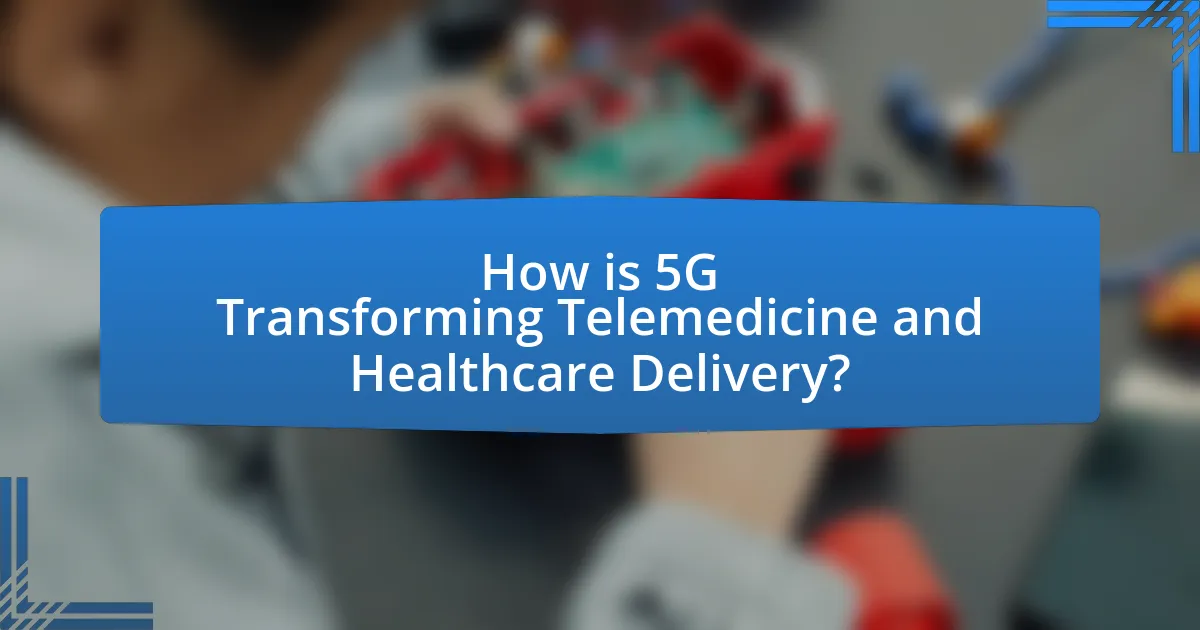5G technology is revolutionizing telemedicine and healthcare delivery by providing ultra-fast data transmission, ultra-low latency, and massive device connectivity. These advancements enable real-time remote consultations, improved patient monitoring, and the integration of advanced technologies such as artificial intelligence and augmented reality. Key features of 5G, including high bandwidth and low latency, enhance the quality of telehealth services, facilitate remote surgeries, and improve access to healthcare, particularly in rural areas. However, the integration of 5G in healthcare also faces challenges such as infrastructure limitations, regulatory hurdles, and cybersecurity concerns that must be addressed to fully leverage its potential.

How is 5G Transforming Telemedicine and Healthcare Delivery?
5G is transforming telemedicine and healthcare delivery by enabling faster data transmission, which facilitates real-time remote consultations and improved patient monitoring. The high-speed connectivity of 5G allows healthcare providers to transmit large medical files, such as high-resolution imaging, instantly, enhancing diagnostic accuracy. According to a report by the International Telecommunication Union, 5G can achieve data rates of up to 10 Gbps, significantly reducing latency to as low as 1 millisecond, which is crucial for applications like remote surgeries and telehealth services. This technological advancement supports the integration of advanced technologies such as augmented reality and artificial intelligence in healthcare, further improving patient outcomes and operational efficiency.
What are the key features of 5G technology that impact telemedicine?
The key features of 5G technology that impact telemedicine include ultra-low latency, high bandwidth, and massive device connectivity. Ultra-low latency, with response times as low as 1 millisecond, enables real-time communication between healthcare providers and patients, facilitating remote surgeries and instant consultations. High bandwidth, reaching up to 10 Gbps, allows for the transmission of high-definition video and large medical files, enhancing the quality of telehealth services. Additionally, 5G supports massive device connectivity, accommodating up to one million devices per square kilometer, which is crucial for the integration of IoT devices in healthcare, such as remote monitoring tools and wearable health devices. These features collectively enhance the efficiency, accessibility, and quality of telemedicine services.
How does increased bandwidth enhance telemedicine services?
Increased bandwidth enhances telemedicine services by enabling faster data transmission, which improves the quality and reliability of virtual consultations. Higher bandwidth allows for high-definition video streaming, reducing latency and ensuring real-time communication between healthcare providers and patients. For instance, studies have shown that 5G technology can support data rates exceeding 1 Gbps, facilitating seamless interactions and the transfer of large medical files, such as imaging scans, without delays. This capability is crucial for accurate diagnoses and effective treatment plans, ultimately leading to better patient outcomes.
What role does low latency play in remote patient monitoring?
Low latency is crucial in remote patient monitoring as it enables real-time data transmission, allowing healthcare providers to respond promptly to patient needs. This immediate communication is essential for monitoring vital signs, detecting emergencies, and facilitating timely interventions, which can significantly improve patient outcomes. Studies indicate that low latency, particularly with 5G technology, can reduce delays in data transfer to less than 1 millisecond, enhancing the effectiveness of remote monitoring systems and ensuring that critical information is available instantly for decision-making.
Why is 5G adoption crucial for healthcare providers?
5G adoption is crucial for healthcare providers because it enables faster data transmission, which is essential for real-time telemedicine applications. The high-speed connectivity of 5G allows healthcare professionals to access and share large medical files, such as high-resolution imaging and patient records, instantly. This capability enhances remote consultations and improves patient outcomes by facilitating timely interventions. Additionally, 5G supports the Internet of Medical Things (IoMT), allowing for seamless integration of connected devices that monitor patient health in real-time, thus improving chronic disease management and reducing hospital readmissions. According to a report by the International Telecommunication Union, 5G can achieve data rates up to 10 Gbps, significantly surpassing the capabilities of previous generations, which is vital for the evolving demands of modern healthcare.
How does 5G improve access to healthcare in rural areas?
5G improves access to healthcare in rural areas by providing high-speed, low-latency connectivity that enables telemedicine services. This enhanced connectivity allows healthcare providers to conduct remote consultations, share medical data in real-time, and utilize advanced technologies such as remote monitoring and virtual reality for patient care. According to a report by the Federal Communications Commission, 5G networks can deliver speeds up to 100 times faster than 4G, significantly reducing the time required for data transmission, which is crucial for timely medical interventions. Additionally, the increased bandwidth supports multiple simultaneous connections, facilitating better access to healthcare resources for rural populations who often face challenges in reaching medical facilities.
What are the implications of 5G for emergency medical services?
5G significantly enhances emergency medical services (EMS) by enabling real-time data transmission, improving communication, and facilitating remote consultations. The high-speed connectivity of 5G allows EMS personnel to transmit patient data, such as vital signs and imaging, to hospitals before arrival, leading to quicker and more informed treatment decisions. For instance, a study by the International Telecommunication Union indicates that 5G can reduce latency to as low as 1 millisecond, which is critical for time-sensitive medical interventions. Additionally, 5G supports the use of advanced technologies like augmented reality for remote guidance during procedures, further improving patient outcomes in emergency situations.
What challenges does the integration of 5G in healthcare face?
The integration of 5G in healthcare faces several challenges, including infrastructure limitations, regulatory hurdles, and cybersecurity concerns. Infrastructure limitations arise from the need for extensive network upgrades and the deployment of new base stations, which can be costly and time-consuming. Regulatory hurdles involve navigating complex healthcare regulations and ensuring compliance with data privacy laws, such as HIPAA in the United States. Cybersecurity concerns are heightened with 5G’s increased connectivity, making healthcare systems more vulnerable to cyberattacks, which can compromise sensitive patient data. These challenges must be addressed to fully realize the potential of 5G in transforming telemedicine and healthcare delivery.
How do security concerns affect the deployment of 5G in telemedicine?
Security concerns significantly hinder the deployment of 5G in telemedicine by raising issues related to data privacy, network integrity, and potential cyberattacks. The sensitive nature of health data makes telemedicine particularly vulnerable; for instance, the Health Insurance Portability and Accountability Act (HIPAA) mandates strict data protection measures, which can complicate the integration of 5G technology. Additionally, the increased connectivity of devices in a 5G environment amplifies the risk of unauthorized access and breaches, as evidenced by reports indicating that healthcare organizations have faced a surge in ransomware attacks, with a 45% increase in 2020 alone. These security challenges necessitate robust encryption and authentication protocols, which can delay the rollout of 5G infrastructure in telemedicine settings.
What infrastructure changes are necessary for 5G implementation?
The infrastructure changes necessary for 5G implementation include the deployment of small cell networks, enhanced fiber optic backhaul, and the installation of advanced antennas. Small cell networks are crucial as they provide the dense coverage required for high-frequency 5G signals, which have a shorter range compared to previous generations. Enhanced fiber optic backhaul is essential to support the increased data traffic and ensure low latency, as 5G networks require significantly more bandwidth than 4G. Additionally, advanced antennas, such as Massive MIMO (Multiple Input Multiple Output), are needed to improve signal quality and capacity, enabling simultaneous connections for multiple users. These changes are validated by industry reports indicating that successful 5G rollout depends on these critical infrastructure upgrades.
How does 5G enhance patient experience in telemedicine?
5G enhances patient experience in telemedicine by providing faster data transmission, lower latency, and improved connectivity. This technology enables real-time video consultations, allowing healthcare providers to interact with patients seamlessly, which is crucial for accurate diagnosis and timely treatment. According to a study by the International Telecommunication Union, 5G can achieve speeds up to 10 Gbps, significantly reducing the time required for data transfer compared to 4G networks. Additionally, the reduced latency of 1 millisecond or less facilitates instant communication, making remote monitoring and virtual visits more effective. Enhanced connectivity also allows for better integration of Internet of Things (IoT) devices, enabling continuous health monitoring and personalized care, ultimately leading to improved patient outcomes and satisfaction.
What are the benefits of real-time consultations enabled by 5G?
Real-time consultations enabled by 5G provide significant benefits, including reduced latency, enhanced video quality, and increased connectivity. The low latency of 5G, often below 1 millisecond, allows healthcare professionals to communicate instantly, which is crucial for urgent medical situations. Enhanced video quality, supported by higher bandwidth, ensures clearer visual communication during consultations, improving diagnostic accuracy. Additionally, 5G’s ability to connect a vast number of devices simultaneously facilitates remote monitoring and telehealth services, allowing healthcare providers to manage multiple patients effectively. These advancements lead to improved patient outcomes and more efficient healthcare delivery.
How does 5G facilitate remote surgeries and advanced medical procedures?
5G facilitates remote surgeries and advanced medical procedures by providing ultra-reliable low-latency communication, which is essential for real-time data transmission. This technology enables surgeons to operate robotic instruments from distant locations with minimal delay, ensuring precision and safety during procedures. For instance, 5G networks can achieve latency as low as 1 millisecond, compared to 4G’s average of 30-50 milliseconds, allowing for seamless control of surgical robots. Additionally, the high bandwidth of 5G supports high-definition video streaming, which is crucial for surgeons to receive real-time visual feedback during operations. This capability enhances collaboration among medical teams, as they can share live video feeds and data instantly, improving decision-making and patient outcomes.
What future trends can we expect from 5G in healthcare delivery?
Future trends in healthcare delivery driven by 5G technology include enhanced telemedicine capabilities, real-time remote monitoring, and improved data transfer speeds. The implementation of 5G is expected to facilitate high-definition video consultations, allowing healthcare providers to deliver more effective remote care. Additionally, 5G will enable continuous monitoring of patients through connected devices, leading to timely interventions and better management of chronic conditions. According to a report by the International Telecommunication Union, 5G networks can achieve data rates up to 10 Gbps, significantly reducing latency and improving the reliability of healthcare applications. This technological advancement will ultimately lead to more personalized and efficient healthcare services.
How might artificial intelligence and 5G converge in telemedicine?
Artificial intelligence and 5G may converge in telemedicine by enabling real-time data processing and enhanced connectivity for remote patient monitoring. The high-speed, low-latency capabilities of 5G allow AI algorithms to analyze vast amounts of health data instantaneously, facilitating timely decision-making in clinical settings. For instance, a study by the International Telecommunication Union highlights that 5G can support up to one million devices per square kilometer, which is crucial for AI-driven applications that require constant data input from wearable health devices. This convergence can lead to improved patient outcomes through more accurate diagnostics and personalized treatment plans.
What innovations in wearable technology are driven by 5G?
5G technology drives innovations in wearable technology by enabling real-time data transmission, enhanced connectivity, and improved device capabilities. This allows wearables to monitor health metrics such as heart rate, blood pressure, and glucose levels with greater accuracy and immediacy. For instance, 5G’s low latency supports remote patient monitoring and telehealth applications, allowing healthcare providers to receive and analyze patient data instantly. Additionally, the increased bandwidth of 5G facilitates the integration of advanced features like augmented reality for surgical training and virtual consultations, enhancing the overall healthcare delivery experience.
What best practices should healthcare providers follow when adopting 5G?
Healthcare providers should prioritize interoperability, security, and patient-centered applications when adopting 5G technology. Interoperability ensures that different systems and devices can communicate effectively, which is crucial for seamless healthcare delivery. Security measures must be robust to protect sensitive patient data, as 5G networks can be more vulnerable to cyber threats. Additionally, focusing on patient-centered applications, such as remote monitoring and telehealth services, can enhance patient engagement and improve health outcomes. These practices are supported by studies indicating that effective 5G implementation can lead to improved operational efficiency and better patient care.


